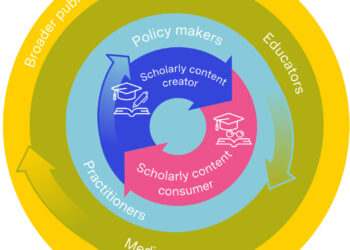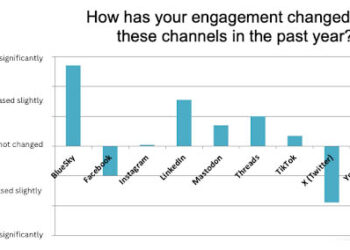 In April, Outsell Inc. released a report titled Open Access 2015: Market Size, Share, Forecast, and Trends (available for $2,595 at http://www.outsellinc.com/store/products/1300). This report seeks to define the size of the open access (OA) market, suggest what is driving it and what trends are in place, identify potential disruptors and competition dynamics, and suggest “essential actions for vendors and imperatives for information managers.” The Scholarly Kitchen was provided a copy of the report, and Rick Anderson subsequently conducted the following email interview with Outsell VP and Lead Analyst Deni Auclair.
In April, Outsell Inc. released a report titled Open Access 2015: Market Size, Share, Forecast, and Trends (available for $2,595 at http://www.outsellinc.com/store/products/1300). This report seeks to define the size of the open access (OA) market, suggest what is driving it and what trends are in place, identify potential disruptors and competition dynamics, and suggest “essential actions for vendors and imperatives for information managers.” The Scholarly Kitchen was provided a copy of the report, and Rick Anderson subsequently conducted the following email interview with Outsell VP and Lead Analyst Deni Auclair.
In the introduction to your report, you indicate that given the “highly controversial and disruptive industry shift” towards OA, publishers are now required to “competitively address the wants and needs of a new customer: the researcher/author,” rather than focusing “on institutional buyers and their budgets.” But haven’t publishers always competed for authors? How has OA changed this particular dynamic?
There are myriad journals, and there are myriad authors wanting to publish in them. As has long been the case, there are those journals about which authors care less and those about which they care more. In the middle is where the competition comes into play and where treating authors as customers, paying attention to their needs, can give a publisher an edge. Authors have to be treated right at every level, but it’s more critical below the top tier because there’s increased competition with squeezed funding and fewer top researchers getting funded – meaning there are more in that middle range. Good publishable research is now more competitive than ever.
At the most basic level, a publisher has to have a system in place to support open access transactions, whatever form they take, if they want authors, institutions or governments to pay to publish with them via open access channels.
What do you see as the biggest impact across the scholarly communication sector of the emergence of megajournals?
Megajournals have raised a lot of questions about the industry and its established practices. One of the biggest impacts, if not the biggest, has been to change the way the industry thinks about journals and articles. Measuring article and author impact, what is commonly known as altmetrics, is a by-product of megajournals taking the focus off of journals and putting it on content. The function and purpose of peer review has also been opened up for even more discussion because PLOS ONE dared to do it differently, as do PeerJ and F1000. But I do think that the discussion around the content “container” is where the biggest impact has been felt so far.
Some will be taken aback that you have deliberately excluded non-APC-based Gold OA journals from your analysis. Could you expand on your reasons for that exclusion?
The list of models in the report includes sponsored and membership journals, but does not include OA journals existing within institutions as cost centers, for example. While this is another well-known model of open access, it does not produce revenues and therefore is not included in the sizing numbers, nor in the list of Gold models. We acknowledge in the report, however, that quite a few journals are published under this model, but specify that they aren’t included in the sizing numbers.
Based on your investigation of scholarly communication market dynamics, how much longer do you expect the impact factor to remain the “coin of the realm” for scholars?
What are the reasons it has stayed top dog for as long as it has? Because nothing else has come along to supplant it in the minds of research institutions and funders. If someone has something they can convince stakeholders to use effectively to determine research impact it will displace the impact factor, but the fact is, it’s a self-perpetuating metric because top researchers want to publish in top journals and top journals are just that because they publish top researchers. How to break that cycle is the question. The simple response is, it will take longer than most open access advocates would like.
What will it take for scholarly societies to engage more enthusiastically with OA? Do you expect this to happen more readily among some disciplines than among others?
The answer to this is pretty simple: if scholarly societies can get the same or better financial results from an open access model than they do from subscriptions, they will change. One of their fears is that the journal is the biggest benefit of membership and unless something else is presented that draws members, they’re stuck. Of course, open access is more appealing to some disciplines than to others, more relevant, so if it takes firmer hold amongst societies, it will be in those disciplines. That is, it would align with current uptake of OA by discipline. The only other scenario we can see is if funder mandates make it impossible to continue to offer subscription journals that members value.
Your analysis suggests that for publishers, “the main motivation for supporting open access is adoption of its philosophy as well as public pressure.” But aren’t many traditional publishers realizing significant revenues from their OA programs? Even PLOS (a nonprofit OA publisher) has begun generating significant surplus revenues. Do you see OA becoming a business opportunity for traditional publishers rather than just a necessary evil for them?
I still believe some publishers would be happy if open access were to disappear, except perhaps those who have invested heavily in infrastructure, but at this point they see it as a vehicle for growth, albeit on a small base, in an industry that craves positive results. It’s kind of like a welcome trickle of water in today’s parched California: it isn’t a raging river or a stream, it’s more a bubbling brook. And with limited revenue potential, given the fact that it basically taps the same sources as subscriptions, OA is something publishers can point to and say that they are supporting, even with its lower margins, for the good of science.
There will be coexistence between OA and subscription, and we aren’t projecting yet where on the scale that will end up being, but given its small size and already slowed growth, we can’t assert at this point that it is a sustainable business model for public companies. While some publishers may be generating profits from OA operations, especially those that are born OA, others have legacy overheads that eat away at those profits. Until they either somehow shed those legacy overheads or generate supplemental income streams, OA will not replace subscription altogether.
The issue of double-dipping and offsetting remains a highly contentious one. Assuming that no publisher (commercial or noncommercial) is likely to open its books fully to the public, what can publishers of hybrid journals do to reassure customers that double-dipping is not actually happening?
Simply put, I think having an intermediary like Jisc involved, as they are with publishers like Elsevier and Wiley, should go a long way to trusting that the issue of double-dipping is effectively addressed. Saying you just have to believe big publishers when they tell you they are addressing double-dipping is of course not going to fly, so the only remedy is either for publishers to open their books, which isn’t likely, or if there is a trusted third party involved.
In your discussion of standards, you suggest that “a standardized taxonomy and reporting system is imperative for relevant information to be discoverable and reportable.” With what player or players in the system do you see the incentive to create such a system lying? Or do you think it will emerge more organically, from competition in the marketplace?
I believe that standards, their place in the ecosystem, and their development, are moving forward because there is understanding that they are needed in order to advance science. Different organizations or groups have different ideas about how that should happen, but nobody believes that it shouldn’t. It isn’t an issue of if, it’s an issue of when standards will be fully implemented and operational, either with single standards leading the way or a bridge system joining systems together so that order can be found in the massive ocean of research that exists today, both text and data.
To summarize, we believe open access is here to stay, but it will not conquer and rule the world of scholarly communication. It has brought a lot of positive change – our industry has changed, and is changing, because of it. But it hasn’t yet set it on its ear. I would love to be around fifty years from now to see what the status is of open access – and of scholarly communications, for that matter – because what this industry does is so critical to the future of the world. That may sound grandiose, but it’s true nonetheless. Scientific research is what can – and, I hope, will – save our world. In the meantime, we continue conducting our own experiments around what will work and what won’t in scholarly communications.
Discussion
11 Thoughts on "Deni Auclair Discusses Outsell’s Open Access Report"
Is there much space for or interest in open access innovation outside of scholarly journal output? The Scholarly Kitchen has its mandate, but what of other forms of content and OA? Raw data, OER, reference works, monographs. It feels a bit to me like the journal and the journal articles have become the proxy for conversation about OA. The risk is of course blinders.
I agree, and I’ve been trying to broaden the discussion beyond STEM journal publishing for years (see the AAUP Statement on Open Access, which appeared in 2007 when I was AAUP president), but with limited success so far.
A couple of quick observations from HighWire’s perspective:
– Our series of researcher interviews turned up an interesting set of distinctions that support the high interest in journals based on principles of “objective review” (e.g., PLOS One, Royal Society Open Science) and preprints (bioRxiv, ArXiv): when reading in an area of his/her own expertise, a researcher feels competent to make expert judgment him/herself. It is when working outside this area that brands (and their implied standards) matter.
– I believe that every new journal launched by HighWire for a society-based publisher in 2014 and 2015 has been an OA journal. (This might have been true in 2013 as well; I don’t have the data ready at hand to analyze.) I won’t offer an interpretation (I can think of several, and they conflict!). It is a small number of titles, so not something that would possibly even show up in Outsell’s data base. And not statistically significant among the set of all new journal titles launched in the “industry”. Whether this is going to cause a redistribution of OA article publishing against a constant volume, or a new set of OA-model articles, I don’t know.
– Perhaps someone from COUNTER can comment on the “double-dipping” question. I thought COUNTER version 4 had a report that helped address this nagging issue.
John
I must say that I had not thought of the point that if a society’s chief membership benefit is its journal(s), then it cannot transition to OA. That is pretty fundamental.
The value of society journals as member benefits is already heavily eroded, because – at least in academic research fields – many if not most of the members interested in a research journal will already have electronic access via licensing deals or similar at their institutions.
This is less true of course for clinical and other practitioner journals, or where members genuinely value having their own print edition
While it is true that most society members cite journals as the most important member benefit, I suspect this has little if any bearing on the lack of enthusiasm among society publishers for OA publishing (there are of course exceptions).
First, this would only be a factor if the society was talking about transitioning its existing portfolio of titles to an OA model. New titles would not pose a risk to the membership model; in fact, publishers could simply offer APC discounts to members.
Second, the membership model has long been under threat by site licensing and has not collapsed. OA poses essentially the same risk as the site license — it does not introduce a new risk. And this is a risk society publishers have lived with for some time.
While site licensing and OA provide strong incentives for societies to calibrate their suite of member benefits beyond journals, the membership model does not accounts for the lack of widespread adoption of OA among society publishers.
Yes, I was specifically referring to transitioning a society’s existing journal portfolio ot OA. If that portfolio is the primary membership benefit then it probably simply cannot be done.
The challenge is not in maintaining membership but rather in recouping the same revenues from APCs as the journals make from site licenses
To Mark Ware’s point above, in academic research fields (as opposed to clinical medicine or engineering), most prospective members already have free (to them) access via institutional site licenses. So if a society’s membership hinges solely on journal subscriptions, they are already in trouble. OA doesn’t make that much worse.
Most societies run selective journals. They attract good papers. They reject a lot of them. They get a decent amount of revenue from site licenses. This model doesn’t work in an OA context. You’d have to accept a lot more papers to make up the revenues, which would change the publications into something else. Which begs the question, why anyone would want to convert selective journals into OA journals? Just start a new OA journal.



